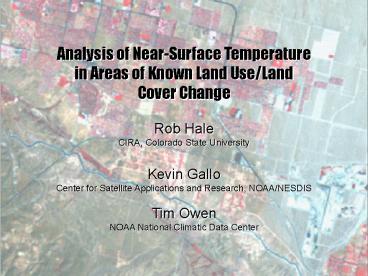Analysis of NearSurface Temperature
1 / 19
Title: Analysis of NearSurface Temperature
1
Analysis of Near-Surface Temperature in Areas of
Known Land Use/Land Cover Change Rob Hale CIRA,
Colorado State University Kevin Gallo Center for
Satellite Applications and Research, NOAA/NESDIS
Tim Owen NOAA National Climatic Data Center
2
Overview
- Purpose to utilize a unique source of land
use/land cover (LULC) data in analyzing the
effects of LULC change on near-surface
temperature measurements - Data and Analysis
- USGS Land Cover Trends
- U.S. Climate Normals stations
- NCEP-NCAR 50-Year Reanalysis
- Results
- Minimum Temperatures
- Maximum Temperatures
- Conclusions
3
USGS Land Cover Trends Project
- 10km or 20km square sample blocks randomly
selected within ecoregions for LULC analysis - Satellite and aerial imagery and ancillary data
used for supervised classification into 11 LULC
types - Nominal years of analysis 1973, 1980, 1986,
1992, and 2000 - 31 ecoregions completed thus far (857 sample
blocks)
4
An Example Mississippi Valley Loess Plains
Ecoregion
1972 MSS
Memphis WSFO
Crop/Pasture ? Urban Forest ? Urban Water ?
Urban
2000 TM
5
U.S. Climate Normals Stations
- 5332 Stations
- Monthly maximum and minimum near-surface
temperature observations - Corrected for time of observation biases and
station and instrument changes - Analyzed anomalies from the 1971-2000 means
6
U.S. Climate Normals Stations
- Identified stations (526) within 10km of Land
Cover Trends sample blocks - Determined the period of greatest single type of
LULC change and what that conversion was
7
U.S. Climate Normals Stations
- Identified stations (526) within 10km of Land
Cover Trends sample blocks - Determined the period of greatest single type of
LULC change and what that conversion was - Limited analyses to stations with at least 2
years of data (both Normals and NNR) before and
after period of greatest LULC change (130)
8
U.S. Climate Normals Stations
- Identified stations (526) within 10km of Land
Cover Trends sample blocks - Determined the period of greatest single type of
LULC change and what that conversion was - Limited analyses to stations with at least 2
years of data (both Normals and NNR) before and
after period of greatest LULC change (130) - Stations also limited to elevations 500m (94)
9
NCEP-NCAR 50-Year Reanalysis (NNR) Data
- Gridded estimates of monthly minimum and maximum
near-surface temperature at 209km resolution - Estimates based on satellite and rawinsonde upper
air data no input of surface-based temperature,
moisture, or wind observations - Values of nearest gridpoints bilinearly
interpolated to Normals station locations - Anomalies from 1979-2000 means utilized for
comparison
10
Results Normals Minimum Temperatures
- Post-change minimum temperatures warmer for all
change types, significant difference for many
types - Overall, significantly warmer post-change minima
11
Results NNR Minimum Temperatures
- As with Normals minimum temperatures, many LULC
conversion types associated with significantly
warmer post-change period minima - Post-change periods significantly warmer overall
12
Results Normals-NNR Differences in Minimum
Temperatures
- Two LULC conversion types (both conversions to
urban) show significantly more post-change
warming in the Normals observations than in the
NNR data - Overall, Normals minimum temperatures showed
significantly greater increases following LULC
conversion than did NNR data for the same periods
13
Results Normals-NNR Differences in Minimum
Temperatures
- Some LULC conversions that might be expected to
produce significant differences did not
14
Results Normals Maximum Temperatures
- Warmer maximum temperatures following LULC change
prevail, but not as ubiquitous as for minimum
temperatures - For all stations combined, maximum temperature
significantly warmer for post-change period
15
Results NNR Maximum Temperatures
- Post-change periods mostly warmer than pre-change
periods many significantly warmer - Warming again not as ubiquitous as for minimum
temperatures
16
Results Normals-NNR Differences in Maximum
Temperatures
- Results more mixed than for minimum temperatures
overall difference not significant - Significantly more post-change warming for
Normals than for NNR for two conversion types
(although n 2 for mechanically disturbed ?
forest)
17
Results Normals-NNR Differences in Maximum
Temperatures
- Again, some maybe unexpected results, including
forest ? urban - Consistent with prior research showing the UHI
effect is more pronounced for minimum
temperatures than maximum temperatures
18
Conclusions
- Urbanization of crop/pastureland resulted in
significant warming of both minimum and maximum
temperatures - Urbanization of forested land resulted in
significant warming of minimum temperatures (but
insignificant warming of maximums) - Clear-cutting of forests and afforestation of
crop/pastureland did not result in significant
changes (min or max)
19
Conclusions
- As more ecoregions are completed by the Land
Cover Trends Project, more stations can be
analyzed to provide greater statistical
confidence in the results































